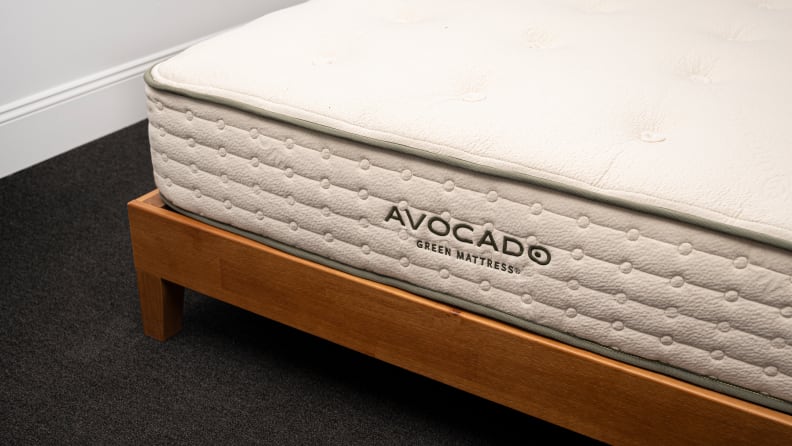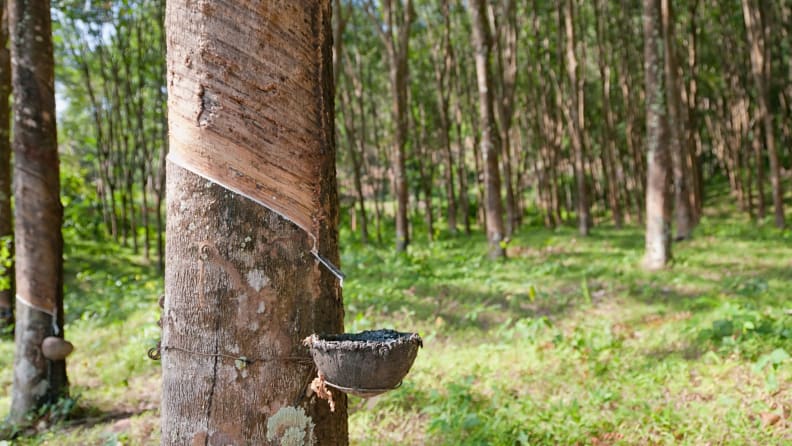Prone to sleeping hot? A latex mattress might be the solution
Latex is, quite literally, one of the coolest mattress foams out there
 Credit:
Getty Images / Adene Sanchez
Credit:
Getty Images / Adene Sanchez
Recommendations are independently chosen by Reviewed's editors. Purchases made through the links below may earn us and our publishing partners a commission. Prices were accurate at the time this article was published but may change over time.
While there are hundreds of mattresses to choose from, there are only a handful of materials on the market. Foam and memory foam are undeniably the biggest players in the bed-in-a-box world. But there’s another material that’s also technically a foam—and you’ve probably heard of it: latex. Brands including Awara, Avocado, and Brooklyn Bedding rely on it to make for cooler nights. Here’s what sets this eco-friendly material apart.
What is latex made of?

Latex made from natural rubber can be more environmentally friendly than polyurethane and memory foam options.
Latex is traditionally made from a naturally derived emulsion that’s produced by tapped Brazilian rubber trees. Of course, latex mattresses don’t rely on the raw material—otherwise they’d be more like water beds than the spongy, springy mattresses we’ve come to associate the material with.
You may have heard of natural and synthetic latexes. When a mattress company brands itself as using “natural latex,” it means that the foam is derived from a rubber tree. As for synthetic latexes, they’re more akin to other foams and are produced with chemicals, says Joshua Gimble, the general manager of Resident Home, the parent company of Awara, Nectar, and DreamCloud.
How are latex mattresses made?

Awara manufactures a bed—made with latex—that feels remarkably similar to a traditional mattress.
Latex follows an interesting—albeit fairly simple—process to get from the liquid that pours from a tree to the foam that’s in a mattress. First, it’s harvested. Then, the liquid is whipped into a frothy substance, Gimble says, and that’s what’s poured into a mold. This is where the manufacturing process diverges, creating two main types of natural latex: Dunlop and Talalay.
Dunlop latex is manufactured through vulcanization, Gimble says. A mold is filled with the frothy liquid and baked at high temperatures to cure the latex. We’re not talking little molds—these are huge molds that produce sheets of latex foam that are then cut to size. According to Gimble, Dunlop tends to have a firmer feel and a more responsive and supportive sensation.
Talalay latex is also made by pouring the foamy liquid into a mold. But there are two extra steps before the substance is cooked. First, it’s vacuum-sealed, creating more air bubbles. Next, the mold is flash-frozen, a process that “pushes carbon dioxide through the latex, making the resulting latex foam light and airy as it solidifies,” according to Saatva. Only then is it baked.
It’s more expensive to produce Talalay latex, as the process is more complicated. However, Talalay latex isn’t necessarily better than Dunlop; the manufacturing simply lends it a slightly different sensation.
Companies may employ other techniques to produce softer or firmer foams, according to Gimble. So when shopping for a mattress, keep in mind that simply looking at the type of latex may not give you a full grasp of the product’s sensation.
What are the benefits of latex mattresses?

The Avocado Green Mattress is one popular bed that utilizes a layer of latex.
Foam mattresses have a reputation for running hot. One of the biggest upshots of natural latex is that it isn’t as prone to sucking in heat from your body and radiating it back to you. Latex has what’s called an “open-cell” foam structure. Instead of the manufacturing process creating isolated bubbles within the foam (like shredded foam used for insulation), the bubbles rupture and form a web-like network. Air can more easily flow through the foam and dissipate.
Naturally derived latex may also be a great choice for eco-conscious consumers, as other foams are made from fossil fuels. While the energy required to make both materials is similar, latex is sourced from trees, and that can be a more eco-friendly base.
What’s more, latex isn’t as prone to off-gassing. After you open a brand-new mattress, it releases chemicals leftover from the manufacturing process that, well, stink. With latex, there aren’t as many chemicals involved. These boxed mattresses still need to expand, but they likely won’t have the same gnarly smell when opened, Gimble says.
The material may also have greater longevity than other foam mattresses, according to Gimble. It’s more responsive and tends to revert back to its original shape really well even over time, he explains.
As the lead mattress tester here at Reviewed, I’ve slept on a couple of mattresses with latex, and I can say that they do have a far springier surface sensation than most other foams. If you want that sink-in, memory foam feel, these aren’t the best choice. But if you don’t mind a more buoyant sensation, a latex mattress might prove perfect.
What’s not great about latex?

The only potential downside of latex is for those with an allergy.
There aren’t many downsides to latex, as far as we can tell.
Even if you have a latex allergy, you’re unlikely to have an allergic reaction to a latex mattress, according to Brooklyn Bedding. (The company cites data from the FDA, but we weren’t able to find the original information online.) Brooklyn Bedding claims that the lack of allergic responses may be attributable to its high-intensity washing process, which “removes any reaction-related proteins.” We’re not sure about all that, so if you have a severe latex allergy, consider checking with your primary care provider or allergist first.
What are some of the best latex mattresses?

Latex isn't as common among online mattress-in-a-box companies.
There are a handful of online mattress companies that use latex in their products. However, the material isn’t as prevalent as memory and polyurethane foams. We’ve tested a handful of companies that use latex to date.
The Awara Organic Luxury Hybrid mattress was a top performer in our testing. In fact, we recognized it for its outstanding edge support and firm sleep surface by dubbing it our Editors’ Choice for the “most like a traditional mattress.” The mattress slept ultra-cool, in keeping with latex’s biggest benefit. Its firm surface makes it great for those who like to sleep on their stomach and back, though our tester found it was good for side sleeping, too.
The Avocado Green mattress was high-performing, even though it—quite literally—fell a few inches short. The mattress was bouncy, supportive, and slept cool, but didn’t even fill our tester’s bedframe. It was two inches short on the top and bottom of a standard queen. If size isn’t a concern, it will prove a comfortable bed that’s great for back and side sleepers, though our tester found it might not be sufficiently supportive for stomach sleepers.
PlushBeds’ Eco-Bliss mattress is made with latex and other materials that the company claims are eco-friendly. We wouldn’t recommend it over the Avocado Green or Awara mattresses, however, because it’s not the best at isolating motion. Translation: You might feel a partner or pet moving about on the bed at night.



